历史
Caltech began as a vocational school founded in Pasadena in 1891 by local businessman and politician Amos G. Throop. The school was known successively as Throop University, Throop Polytechnic Institute, and Throop College of Technology, before acquiring its current name in 1921.
At a time when scientific research in the United States was still in its infancy, George Ellery Hale, a solar astronomer from the University of Chicago, founded the Mount Wilson Observatory in 1904. He joined Throop's board of trustees the same year, and soon began developing it and the whole of Pasadena into a major scientific and cultural destination. He engineered the appointment of James A. B. Scherer, a literary scholar untutored in science but a capable administrator and fundraiser, to Throop's presidency in 1908. Scherer persuaded retired businessman and trustee Charles W. Gates to donate $25,000 in seed money to build Gates Laboratory, the first science building on campus. The promise of the lab attracted physical chemist Arthur Amos Noyes to commit to developing the institution. Arther Fleming, Caltech's primary benefactor, who had donated the land for the permanent campus site at California and Wilson, later donated $100,000 to establish a physics facility, the Norman Bridge Laboratory, which succeeded in attracting experimental physicist Robert Andrews Millikan to join the faculty and assist in establishing the college as a center for science and technology.

Throop Polytechnic Institute, Pasadena, Calif, 1908. This photo was taken on the original campus in downtown Pasadena; in 1910 the Institute moved to its present location.
The vocational school was disbanded, and the preparatory program was split off into an independent Polytechnic School in 1910. In 1911, a bill was introduced in the California Legislature calling for the establishment of a publicly funded "California Institute of Technology," with an initial budget of a million dollars, ten times the budget of Throop at the time. The board of trustees offered to turn Throop over to the state, but the presidents of Stanford and the University of California successfully lobbied to defeat the bill, which allowed Throop to develop as the only scientific research-oriented education institute in Southern California, public or private, until the onset of the Second World War necessitated the broader development of research-based science education.
With the onset of World War I, Hale organized the National Research Council to coordinate and support scientific work on military problems. While he supported the idea of federal appropriations for science, he took exception to a federal bill that would have funded engineering research at land-grant colleges, and instead sought to raise a $1 million national research fund entirely from private sources. To that end, as Hale wrote in the New York Times:
Throop College of Technology, in Pasadena California has recently afforded a striking illustration of one way in which the Research Council can secure co-operation and advance scientific investigation. This institution, with its able investigators and excellent research laboratories, could be of great service in any broad scheme of cooperation. President Scherer, hearing of the formation of the council, immediately offered to take part in its work, and with this object, he secured within three days an additional research endowment of one hundred thousand dollars.
Through the National Research Council, Hale simultaneously lobbied for science to play a larger role in national affairs, and for Throop to play a national role in science. The new funds were designated for physics research, and ultimately lead to the establishment of the Norman Bridge Laboratory, which attracted Millikan from the University of Chicago. During the course of the war, Hale, Noyes and Millikan worked together in Washington on the NRC. Subsequently, they continued their partnership in developing Caltech.
Under the leadership of Hale, Noyes, and Millikan (and aided by the booming economy of Southern California), Caltech grew to national prominence in the 1920s. In 1923, Millikan was awarded the Nobel Prize in physics. In 1925, the school established a department of geology and hired William Bennett Munro, then chairman of the division of History, Government, and Economics at Harvard University, to create a division of humanities and social sciences at Caltech. In 1928, a division of biology was established under the leadership of Thomas Hunt Morgan, the most distinguished biologist in the United States at the time, and discoverer of the role of genes and the chromosome in heredity. In 1930, Kerckhoff marine laboratory was established in Corona del Mar under the care of Professor George MacGinitie. In 1926, a graduate school of aeronautics was created, which eventually attracted Theodore von Kármán. Kármán later helped create the Jet Propulsion Laboratory, and played an integral part in establishing Caltech as one of the world's centers for rocket science. In 1928, construction of the Palomar Observatory began.
Millikan served as "chairman of the executive council" (effectively Caltech's president) from 1921 to 1945, and his influence was such that the Institute was occasionally referred to as "Millikan's School." In the 1950s, 1960s, and 1970s, Caltech was the home of Murray Gell-Mann and Richard Feynman, whose work was central to the establishment of the so-called "Standard Model" of particle physics. Feynman was also widely known outside the physics community as an exceptional teacher and colorful, unconventional character.
Caltech remains, to this day, a small and highly focused university, with approximately 900 undergraduates, 1300 graduate students, and over 1000 faculty members (including 293 professors, 104 emeritus professors, 66 permanent research faculty, 87 visiting faculty, and over 500 postdoctoral scholars). A private institution, Caltech is governed by its Board of Trustees.
As of 2006, Caltech has 31 Nobel laureates to its name. This figure includes 17 alumni, 14 non-alumni professors, and 4 professors who were also alumni (Carl D. Anderson, Linus Pauling, William A. Fowler, and Edward B. Lewis). The number of awards is 32, because Pauling received prizes in both Chemistry and Peace. With fewer than 25,000 alumni in total, more than one in 1,400 have received the Nobel Prize — a ratio unmatched by any other university. Five faculty and alumni have received a Crafoord Prize from the Royal Swedish Academy of Sciences, while 49 have been awarded the U.S. National Medal of Science, and 10 have received the National Medal of Technology. Other distinguished researchers have been affiliated with Caltech as postdoctoral scholars (e.g., Barbara McClintock, James D. Watson, and Sheldon Glashow) or visiting professors (e.g., Albert Einstein and Edward Witten).
Caltech manages the Jet Propulsion Laboratory (JPL) for NASA. The majority of NASA's interplanetary probes are developed at and operated from JPL.
The Spitzer Science Center (SSC), located on the Caltech campus, is the data analysis and community support center for NASA's Spitzer Space Telescope. The SSC, part of the Infrared Processing and Analysis Center (IPAC), works in collaboration with the Jet Propulsion Laboratory.
校园
In 1917 Hale hired architect Bertram Goodhue to produce a master plan for the 22 acre (89,000 m²) campus. Goodhue conceived the overall layout of the campus and designed the physics building, Dabney Hall, and several other structures, in which he sought to be consistent with the local climate, the character of the school, and Hale's educational philosophy. Goodhue's designs for Caltech were also influenced by the traditional Spanish mission architecture of Southern California.
In 1971 a magnitude-6.5 earthquake in San Fernando caused some damage to the Caltech campus. Engineers who evaluated the damage found that two historic buildings dating from the early days of the Institute — Throop Hall and the Goodhue-designed Culbertson Auditorium — had cracked. These were some of the first reinforced concrete buildings, and their plans did not contain enough details (such as how much reinforcing bar had been embedded in the concrete) to be sure they were safe, so the engineers recommended demolition. However, demolishing these historic structures required considerably more effort than would have been necessary had they been in real danger of collapse. A large wrecking ball was used to demolish Throop Hall, and smashing the concrete revealed massive amounts of rebar, far in excess of safety requirements. The rebar had to be cut up before the pieces could be hauled away, and the process took much longer than expected.
In 2008 Caltech completed a 238 kW solar array projected to produce approximately 320,000 kWh in 2009.
学术
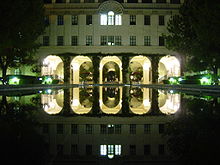
Beckman Institute at night
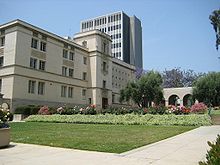
Bridge Laboratory of Physics
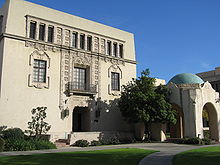
Kerckhoff Laboratory of the Biological Sciences
Academics at Caltech emphasize quality over size, concentrating on a core of academic disciplines of very high caliber. Caltech is also known for interdisciplinary programs facilitated by the small physical size of the Caltech campus.
Conversely, as a small school, Caltech cannot and does not offer the breadth of academic programs possible at larger universities. It does, however, offer co-operative programs with other schools, such as the Pasadena Art Center College of Design, Occidental College, UCLA, and Scripps College.
Caltech is divided into six divisions, each of which offer several degree programs, plus a number of interdisciplinary programs. The six divisions are:
- Division of Biology
- Division of Chemistry and Chemical Engineering
- Division of Engineering and Applied Science
- Division of Geological and Planetary Sciences
- Division of Humanities and Social Sciences
- Division of Physics, Mathematics, and Astronomy
Undergraduate program
Caltech is on the trimester system. Because of its schedule, Caltech's school year starts relatively late, in late September, and ends in early June rather than May as at the more common semester-system colleges. Also, Caltech is unusual in that students normally take five classes every term rather than four, as at most colleges. Instead of majors, Caltech has "options", and until 2006 offered only one minor: in control and dynamical systems. During the spring term of 2006 the humanities and social sciences division announced its plans to introduce four more minors in English, history, philosophy, and history and philosophy of science. Approximately 20 percent of students double-major. This is achievable since the humanities and social sciences majors have been designed to be done in conjunction with a science major. Although choosing two options in the same division is discouraged, it is still possible.
For the core curriculum, students are required to take five terms of math, including differential equations, probability and statistics, five terms of physics including quantum mechanics, special relativity, and statistical mechanics, two terms of chemistry, and a term of biology, as well as two terms of laboratory classes.
Very few students fail classes or fail out of the school as a whole. This is due to several cushions that help students survive. First of all, the first two terms of freshman year are on a pass/fail grading scheme, easing the transition to college and reducing academic stress. During the second term, "shadow grades" are given to help students gauge their own progress; during the first term, there are no grades at all. Second, there is little competition; collaboration on homework is encouraged (and often necessary for success) in almost every class. This allows even students who are not doing as well as others to learn the material from their peers and not get behind in their studies. Another helpful factor is the Honor System; this system encourages take-home tests, flexible homework schedules, and other freedoms, alleviating some of the practical burdens associated with a five-to-seven course workload.
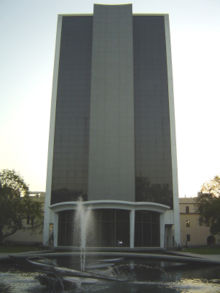
Millikan Library, the tallest building on campus
Caltech has a relatively low four-year graduation rate, compared to most leading US universities. This rate is currently about 80 percent, despite the fact that entering students have consistently higher average test scores (on the SAT 1 and 2) than any other university or college, as indicated by the major college rankings. On the other hand, almost all students major in science or engineering, fields that traditionally suffer low graduation rates. In any case, the situation has improved recently; approximately 90 percent of entering students graduate in six years or less, compared to a substantially smaller fraction in the 1960s and 70s.
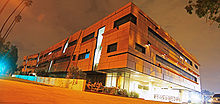
The Cahill Center for Astronomy and Astrophysics
Undergraduates at Caltech are also encouraged to participate in research. About half of students do research through the annual Summer Undergraduate Research Fellowships (SURF) program at least once during their stay, and many continue it during the school year. Students write and submit SURF proposals for research projects in collaboration with professors, and about 70 percent of applicants are awarded SURFs. The program is open to both Caltech and non-Caltech undergraduate students. It serves as preparation for graduate school and helps to explain why Caltech has one of the highest percentages of alumni who go on to receive a Ph.D. of all the major universities.
体育运动
Caltech has athletic teams in baseball, men's & women's basketball, cross country, fencing, men's soccer, swimming & diving, men's & women's tennis, track & field, women's volleyball, and men's & women's water polo. Caltech's mascot is the Beaver, and its teams (with the exception of the fencing team) play in the Southern California Intercollegiate Athletic Conference, which Caltech co-founded in 1915. The fencing team competes in the NCAA's Division I, facing teams from USC, UCLA, UCSD, and Stanford, among others.
On January 6, 2007, the Beavers' men's basketball team snapped a 207-game losing streak to Division III schools, beating Bard College 81-52. It was their first Division III victory since 1996. They still carry a 259 game losing streak in conference play. The documentary film Quantum Hoops concerns the events of the Beavers' 2005-6 season.
On January 13, 2007, the Caltech women's basketball team snapped a 50-game losing streak, defeating the Pomona-Pitzer Sagehens 55-53. The women's program, which entered the SCIAC in 2002, garnered their first conference win. On the bench as honorary coach for the evening was Dr. Robert Grubbs, 2005 Nobel Laureate in Chemistry. The team went on to beat Whittier College on February 10, for its second SCIAC win, and placed its first member on the All Conference team. The 2006-2007 season is the most successful season in the history of the program.
On March 5, 2009, the Soccer team snapped a 201-game losing streak to Pomona-Pitzer 1-0.
In 2007, 2008, and 2009, the women's table tennis team (a club team) competed in nationals. The women's Ultimate club team, known as "Snatch", has also been very successful in recent years, ranking 44 of over 200 college teams in the Ultimate Player's Association.
Student life
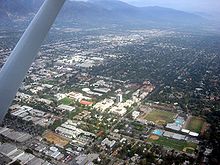
Aerial view of Caltech in Pasadena, California.
[edit] House system
Main article: House System at Caltech
During the early 20th century, a Caltech committee visited several universities and decided to transform the undergraduate housing system from regular fraternities to a house system. Four south houses (or hovses) were built: Blacker House, Dabney House, Fleming House, and Ricketts House. In the 1960s, three north houses were built: Lloyd House, Page House, and Ruddock House, and during the 1990s, Avery House. The four south houses closed for renovation in 2005 and reopened in 2006.
Student life traditions
Annual events
Every Halloween, Dabney House conducts the infamous "Millikan pumpkin-drop experiment" from the top of Millikan Library, the highest point on campus. According to tradition, a claim was once made that the shattering of a pumpkin frozen in liquid nitrogen and dropped from a sufficient height would produce a triboluminescent spark. This yearly event involves a crowd of observers, who try to spot the elusive spark. The title of the event is an oblique reference to the famous Millikan oil-drop experiment which measured e, the elemental unit of electrical charge.
On Ditch Day the seniors ditch school, leaving behind elaborately designed tasks and traps at the doors of their rooms to prevent underclassmen from entering. Over the years this has evolved to the point where many seniors spend months designing mechanical, electrical, and software obstacles to confound the underclassmen. Each group of seniors designs a "stack" to be solved by a handful of underclassmen. The faculty have been drawn into the event as well, and cancel all classes on Ditch Day so the underclassmen can participate in what has become a highlight of the academic year. In 2007, Ditch Day fell on May 15. In 2008, on May 21.
Another long-standing tradition is the playing of Wagner's ominous Ride of the Valkyries at 7:00 each morning during finals week with the largest, loudest speakers available. The playing of that piece is not allowed at any other time (except if one happens to be listening to the entire fifteen hours of The Ring Cycle), and any offender is dragged into the showers to be drenched in cold water fully dressed. The playing of the Ride is such a strong tradition that the music was used during Apollo 17 to awaken Astronaut Harrison Schmitt, a Caltech alumnus. (Unfortunately, the tradition arose at different times in different Houses, so Schmitt did not react as expected. Instead, he just became confused.)
Pranks
Caltech students have been known for the many pranks (also known as RFs).
The two most famous in recent history are the changing of the Hollywood Sign to read "Caltech", by judiciously covering up certain parts of the letters, and the changing of the Rose Bowl scoreboard to an imaginary game where Caltech beat MIT 99-0. But the most famous of all occurred during the 1961 Rose Bowl Game, where Caltech students altered the flip-cards that were raised by the stadium attendees to display "Caltech", and several other "unintended" messages. This event is now referred to as the Great Rose Bowl Hoax.
In 2005, a group of Caltech students pulled a string of pranks during MIT's Campus Preview Weekend for admitted students. These include covering up the word Massachusetts in the "Massachusetts Institute of Technology" engraving on the main building façade with a banner so that it read "That Other Institute of Technology". A group of MIT hackers responded by altering the banner so that the inscription read "The Only Institute of Technology." Caltech students also passed out T-shirts to MIT's incoming freshman class, with MIT on the front and "... because not everyone can go to Caltech" along with an image of a palm tree on the back.
MIT retaliated in April 2006, when students posing as the Howe & Ser Moving Company stole the 130-year-old, 1.7-ton Fleming House cannon and moved it to their campus in Cambridge, Massachusetts for their 2006 Campus Preview Weekend, repeating a similar prank performed by nearby Harvey Mudd College in 1986. (The name "Howe & Ser", if said rapidly, and if read recognizing that the & symbol is a ligature of the Latin word "et", sounds like howitzer; it could also mean "how we answer", since the latest prank was an answer to the 2005 prank on MIT.) Thirty members of Fleming House traveled to MIT and reclaimed their cannon on April 10, 2006.
On April 13, 2007 (Friday the 13th), a group of students from The California Tech, Caltech's campus newspaper, arrived and distributed fake copies of The Tech, MIT's campus newspaper, while prospective students were visiting for their Campus Preview Weekend. Articles included "MIT Invents the Interweb," "Architects Deem Campus 'Unfortunate'," and "Infinite Corridor Not Actually Infinite."
In recent years, pranking has been officially encouraged by Tom Mannion, Caltech's Assistant VP for Student Affairs and Campus Life. "The grand old days of pranking have gone away at Caltech, and that's what we are trying to bring back," reported the Boston Globe, which noted that "security has orders not to intervene in a prank unless officers get Mannion's approval beforehand."
Caltech pranks have been documented in three Legends of Caltech books, the most recent of which was edited by alumni Autumn Looijen '99 and Mason A. Porter '98 and published in May 2007.
In December 2009, some Caltech students declared that MIT has been sold and has become the Caltech East campus. A "sold" banner was hung on front of the MIT humanities building and a "Caltech east" banner inside.
Honor Code
Life in the Caltech community is governed by the Honor Code, which simply states: "No member of the Caltech community shall take unfair advantage of any other member of the Caltech community." This is enforced by a Board of Control, which consists of undergraduate students, and by a similar body at the graduate level, called the Graduate Review Board.
The Honor Code aims at promoting an atmosphere of respect and trust that allows Caltech students to enjoy privileges that make for a more relaxed atmosphere. For example, the Honor Code allows professors to make the majority of exams as take-home, allowing students to take them on their own schedule and in their preferred environment.
Through the late 1990s, the only exception to the Honor Code, implemented earlier in the decade in response to changes in federal regulations, concerned the sexual harassment policy. Today, there are myriad exceptions to the Honor Code in the form of new institute policies such as the Fire Policy, and Alcohol Policy. Though both policies are presented in the Honor Code Handbook given to new members of the Caltech Community, large portions of the undergraduate population regard them as a slight against the Honor Code and the implicit trust and respect it represents within the community.
In media and popular culture
Caltech has appeared in several works of popular culture, both as itself and in disguised form. As with MIT, a Caltech reference is often used to establish a character's high level of intelligence or a technical background. For example, on television, the four lead characters of the sitcom The Big Bang Theory are all employed at the Institute. Caltech is also the inspiration, and frequent film location, for the California Institute of Science of Numb3rs. On film, the Pacific Tech of The War of the Worlds and Real Genius is based on Caltech. In nonfiction, two 2007 documentaries examine aspects of Caltech; Curious, its researchers, and Quantum Hoops, its men's basketball team.
Given its Los Angeles-area location, the grounds of the Institute are often host to short scenes in movies and television. The Athenaeum dining club appears in the Beverly Hills Cop series, The X-Files, and True Romance. Other examples include Legally Blonde, The Wedding Planner, Greek, The O.C., Entourage and Mission Impossible.
Notable alumni, faculty, and staff
Main article: List of California Institute of Technology people
17 alumni and 14 non-alumni faculty have won the Nobel Prize. The Turing Award, the "Nobel Prize of Computer Science", has been awarded to six alumni.
Alumni have participated in scientific research. Some have concentrated their studies on the very small universe of atoms and molecules. Nobel laureate Carl D. Anderson (BS 1927, PhD 1930) proved the existence of positrons and muons, Nobel laureate Edwin McMillan (BS 1928, MS 1929) synthesized the first transuranium element, Nobel laureate Leo James Rainwater (BS 1939 ) investigated the non-spherical shapes of atomic nuclei, and Nobel laureate Douglas D. Osheroff (BS 1967) studied the superfluid nature of helium-3.
Other alumni have turned their gaze to the galactic universe. C. Gordon Fullerton ( BS 1957, MS 1958) piloted the third space shuttle mission and orbited the earth in Skylab. Astronaut (and later, United States Senator) Harrison Schmitt (BS 1957) was the only geologist to have ever walked on the surface of the moon. Astronomer Eugene Merle Shoemaker (BS 1947, MS 1948) co-discovered Comet Shoemaker-Levy 9 (a comet which crashed into the planet Jupiter) and was the first person buried on the moon (by having his ashes crashed into the moon).
Undergraduate alumni founded, or co-founded, companies such as LCD manufacturer Varitronix HotMail, Compaq, and The MathWorks (which created Matlab), while graduate students founded, or co-founded, companies such as Intel , TRW , and the Exploratorium .
Arnold Beckman (PhD 1928) invented the pH meter and commecialized it with the founding of Beckman Instruments. His success with that company enabled him to provide seed funding for William Shockley (BS 1932), who had co-invented semiconductor transistors and wanted to commercialize them. Because his aging mother was living in Palo Alto, California at the time, Shockley decided to establish his laboratory near her in 1955, in neighboring Mountain View, California , and thus, Shockley became the founding Director of the Shockley Semiconductor Laboratory divison of Beckman Instruments. Shockely was a co-recipient of the Nobel Prize in physics in 1956, but his aggressive management style and odd personality at the Shockley Lab became unbearable . In late 1957, eight of his researchers, known now as the "Traitorous Eight" (or "Fairchildren"), resigned and joined Fairchild Camera and Instruments nearby to form a semiconductor divison. Among the "Traitorous Eight" was Gordon E. Moore (PhD 1954) , who left Fairchild to co-found Intel. Other offspring companies of Fairchild Semicondutor include National Semiconductor and Advanced Micro Devices, which in turn spawned more technology companies in the area. Shockley's decision to use silicon -- instead of germanium -- as the semiconductor material, coupled with the abundance of silicon semiconductor related companies in the area, gave rise to the term "Silicon Valley" to describe that geographic region surrounding Palo Alto.
Nobel laureate Carl David Anderson, BS 1927, PhD 1930, discoverer of the positron and the muon
|
Nobel laureate Douglas D. Osheroff, BS 1967
|
Nobel laureate James Rainwater, BS 1939
|
Nobel laureate William Shockley, BS 1932, co-inventor of the solid state transistor, father of Silicon Valley
|
Nobel laureate Edwin McMillan, BS 1928, MS 1929
|
Nobel laureate Vernon Smith, BS 1949
|
Turing Award laureate Fernando J. Corbató, BS 1950
|
Turing Award laurate John McCarthy, BS 1948, inventor of the Lisp programming language
|
Astronaut C. Gordon Fullerton, BS 1957, MS 1958
|
Astronaut and United States Senator Harrison Schmitt, BS 1957; the only geologist to have walked on the moon.
|
Gordon Moore, PhD 1954, co-founder of Intel
|
National Medal of Technology laureate Carver Mead, BS 1956, MS 1957, PhD 1960
|
Benoît Mandelbrot, MS 1948, Engineering 1949, father of fractal geometry, namesake of the Mandelbrot set
|
Frank Capra, BS Chemical Engineering 1918 (when Caltech was known as the "Throop Institute"); winner of six Academy Awards in directing and producing; producer and director of It's a Wonderful Life
|
Sandra Tsing Loh, BS 1983, performance artist, broadcaster, and writer
|
Presidents
- James Augustin Brown Scherer (1908–1920) (president of Throop College of Technology before the name change)
- Robert A. Millikan (1921–1945), experimental physicist, Nobel laureate in physics for 1923 (his official title was "Chairman of the Executive Council")
- Lee A. DuBridge (1946–1969), experimental physicist (first to officially hold the title of President)
- Harold Brown (1969–1977), physicist and public servant (left Caltech to serve as United States Secretary of Defense in the administration of Jimmy Carter)
- Robert F. Christy (1977–1978), astrophysicist (acting President)
- Marvin L. Goldberger (1978–1987), theoretical physicist
- Thomas E. Everhart (1987–1997), experimental physicist
- David Baltimore (1997–2006), molecular biologist, Nobel laureate in physiology or medicine for 1975
- Jean-Lou Chameau (2006–present), civil engineer and educational administrator
更多
 |
University portal |
 |
Education portal |
- Caltech Submillimeter Observatory
- Einstein Papers Project
- Keck Institute for Space Studies
- List of California Institute of Technology people
- List of California Institute of Technology trustees
参考文献
- ^ As of June 30, 2009. "U.S. and Canadian Institutions Listed by Fiscal Year 2009 Endowment Market Value and Percentage Change in Endowment Market Value from FY 2008 to FY 2009" (PDF). 2009 NACUBO-Commonfund Study of Endowments. National Association of College and University Business Officers. http://www.nacubo.org/Documents/research/2009_NCSE_Public_Tables_Endowment_Market_Values.pdf. Retrieved March 16, 2010.
- ^ "Caltech: At a Glance". http://www.caltech.edu/at-a-glance/. Retrieved 2009-12-21.
- ^ "Caltech Office of the Registrar Enrollment Statistics". http://www.registrar.caltech.edu/statistics.htm. Retrieved 2009-12-21.
- ^ The university itself only spells its short form as "Caltech"; other spellings such as "Cal Tech" and "CalTech" are incorrect. The Institute is also occasionally referred to as "CIT", most notably in its alma mater, but this is uncommon.
- ^ Globaluniversitiesranking.org
- ^ "Harvard Rides High in Latest "Top Ten" Research Roundup". ScienceWatch. September/October 2002. http://www.sciencewatch.com/sept-oct2002/sw_sept-oct2002_page1.htm. Retrieved 2009-04-25.
- ^ "Nobel Laureates and Universities". Nobel Foundation. http://nobelprize.org/nobel_prizes/lists/universities.html. Retrieved 2009-04-25.
- ^ Goodstein, Judith (1998-06-29). "History of Caltech". NobelPrize.org. http://nobelprize.org/nobel_prizes/physics/articles/goodstein/index.html. Retrieved 2007-11-19.
- ^ Goodstein, Judith R. (1991). "Preamble to a Technical School". Milikan's School: A History of the California Institute of Technology. New York: W. W. Norton & Company. pp. 51–63. ISBN 0-393-03017-2.
- ^ Goodstein, Judith R. (1991). "The Birth of Caltech". Milikan's School: A History of the California Institute of Technology. New York: W. W. Norton & Company. pp. 71–75. ISBN 0-393-03017-2.
- ^ Starr, Kevin (1997). "Unto the Stars Themselves, Astronomy and the Pasadena Perspective". The Dream Endures: California Enters the 1940s. Oxford: Oxford University Press. pp. 74–77. ISBN 0-19-515797-4.
- ^ Goodstein, Judith R. (1991). "The Birth of Caltech". Milikan's School: A History of the California Institute of Technology. New York: W. W. Norton & Company. pp. 64–75. ISBN 0-393-03017-2.
- ^ At a Glance Caltech.edu. Retrieved 2007-11-19.
- ^ "Caltech solar project receives city rebate". Caltech press release. 2008-09-16. http://media.caltech.edu/press_releases/13183. Retrieved 2010-04-16.
- ^ Caltech Common Data Set 2004-05. Retrieved 2007-11-19.
- ^ "America's Best Colleges 2008" U.S. News and World Report College Rankings. Retrieved 2007-11-19.
- ^ Caltech Athletics. Retrieved 2007-11-19.
- ^ Southern California Intercollegiate Athletic Conference. Retrieved 2007-11-19.
- ^ "Caltech Athletics — Fencing Team". Athletics.caltech.edu. http://www.athletics.caltech.edu/sports/fencing/fencing.html. Retrieved 2009-10-13.
- ^ Associated Press (2007-01-07). "Caltech crushes Bard College to end 207-game slide". ESPN. http://sports.espn.go.com/ncb/news/story?id=2723039. Retrieved 2007-11-19.
- ^ "Caltech Athletics". Athletics.caltech.edu. http://www.athletics.caltech.edu/. Retrieved 2009-10-13.
- ^ "Pomona-Pitzer College vs Caltech (01-13-07 at Caltech Braun Center)". 2007-01-13. http://www.physical-education.pomona.edu/womens/basketball/stats/2007/pom-cit.htm. Retrieved 2007-11-19.
- ^ "2007 Women's Basketball All-SCIAC Awards". 2007-03-07. http://www.thesciac.org/sports/wbkb/2006-07/news/wbb_allsciac_0607. Retrieved 2007-11-19.
- ^ College Women's Top UPA Rankings, Ultimate Player's Association. Retrieved 2007-11-19.
- ^ "Comedy on campus: MIT takes on Caltech for prank distinction". The Boston Globe. 2006-04-19. http://www.boston.com/news/local/articles/2006/04/19/comedy_on_campus_mit_takes_on_caltech_for_prank_distinction/. Retrieved 2007-11-19.
- ^ Caltech Opens Humanities School at MIT Campus, December 6, 2009
- ^ Citybeats: Future Tournament of Roses chief vows even better parades, Pasadena Star-News, December 6, 2009
- ^ "The Honor System Handbook from the Board of Control at Caltech.edu". Donut.caltech.edu. http://donut.caltech.edu/about/boc/ug_handbook.php. Retrieved 2009-10-13.
- ^ "Graduate Review Board at Caltech.edu". Its.caltech.edu. 2009-06-10. http://www.its.caltech.edu/~grb/. Retrieved 2009-10-13.
- ^ Rodriguez, Juan (2003-02-24). "Ricketts Pres. Apologizes". The California Tech. p. 5.
- ^ Caltech References in "Real Genius". Retrieved 2007-11-19.
- ^ Cowan, Douglas E. "Intellects vast and cool and unsympathetic: Science, Religion, and The War of the Worlds." Journal of Religion and Film, Vol. 11, No. 1, 1 April 2007.
- ^ ""CURIOUS" from Thirteen/WNET". Thirteen.org. http://www.thirteen.org/curious/. Retrieved 2009-10-13.
- ^ "Documentary Focuses on Caltech Researchers" Caltech Press Release, 1 October 2007
- ^ "Film locations for Beverly Hills Cop". Movie-locations.com. http://www.movie-locations.com/movies/b/bevhills.html. Retrieved 2009-10-13.
- ^ Deborah Lee Soltesz. "USGS Astrogeology: Astronaut Harrison H. Schmitt". United States Geological Survey - Astrogeology Program. http://astrogeology.usgs.gov/About/AstroHistory/schmitt.html.
- ^ "In 1998, Celestis, at the request of NASA, provided a Luna Flight Capsule to the family and friends of the late legendary astronomer and planetary geologist Eugene Shoemaker. The Celestis Flight Capsule, containing a symbolic portion of Shoemaker's cremated remains, was attached to NASA's Lunar Prospector spacecraft and launched on a one-year mission orbiting the moon. On July 31, 1999, at the completion of Lunar Prospector's mission, the spacecraft was intentionally crashed into the moon's south pole, making Shoemaker the first human to be laid to rest on another celestial body. NASA called the memorial "a special honor for a special human being.""Clara Moskowitz (2008-03-28). "Fly Me to the Moon...Forever". Space.com. http://www.space.com/news/080328-moon-burial.html.
- ^ York Liao (BS 1967)Caltech News (1997 (Vol. 31, No. 2, 1997)). "Caltech Alumni Album Profiles '50s, '60s, '70s and '80s - York Liao ’67". California Institute of Technology. http://pr.caltech.edu/periodicals/CaltechNews/articles/archive/AlumniAlbum3_97/.
- ^ Sabeer Bhatia, BS 1991Caltech Media Relations (2008-07-18). "SURFing the Waves of Success for 30 Years". California Institute of Technology. http://media.caltech.edu/press_releases/13166.
- ^ Benjamin Rosen, BS 1954Caltech Alumni Association. "Distinguished Alumni Award - Benjamin M. Rosen". Caltech Alumni Association. http://alumni.caltech.edu/distinguished_alumni/search_results?search_text=Benjamin+Rosen.
- ^ Cleve Moler, BS 1961 "Cleve Moler Elected Next SIAM President". Society for Industrial and Applied Mathematics. 2005-12-16. http://www.siam.org/about/news-siam.php?id=171.
- ^ Gordon Moore, PhD 1954Caltech Alumni Association. "Distinguished Alumni Award - Gordon E. Moore". Caltech Alumni Association. http://alumni.caltech.edu/distinguished_alumni/search_results?search_text=Gordon+Moore.
- ^ Simon Ramo, PhD 1936 Caltech Public Relations (2010-02-24). "The Singular Si Ramo". Caltech Today (via California Institute of Technology). http://today.caltech.edu/today/story-display.tcl?story_id=42622.
- ^ Frank Oppenheimer, PhD 1939 Caltech Alumni Association. "Frank Oppenheimer". Caltech Alumni Association. http://alumni.caltech.edu/distinguished_alumni/search_results?search_text=Frank+Oppenheimer.
- ^ Bill Roberts (2005-11-01). "The Ten Most Influential Executives". EDN. http://www.edn.com/article/CA6279562.html.
- ^ The Nobel Foundation (1956). "William B. Shockley - Biography". The Nobel Prize Committee (official site). http://nobelprize.org//nobel_prizes/physics/laureates/1956/shockley-bio.html.
- ^ "How he was miserable is more complicated than even I could get into a hundred thousand word book. There was something wrong with him. What was wrong with him, we don't really know. He was at best paranoid. He was probably obsessive-compulsive. The manuscript of the book has been shown to about six or seven psychotherapist, and I asked them for a diagnosis, and they came back with six or seven different diagnoses." Ira Flatow (interview) with journalist Joel Shurkin (2006-07-21). "Electronics Pioneer William Shockley's Legacy". National Public Radio. http://www.npr.org/templates/story/story.php?storyId=5573656.
- ^ "Shockley, whose role as coinventor of the transistor would win him a share of the 1956 Nobel Prize in physics, succeeded in luring a diverse group of accomplished scientists, including Moore, to the Shockley Semiconductor Laboratory, in Palo Alto, California. He then proceeded to antagonize and alienate enough of them to inspire an exodus."Hillary Bhaskaran (2002 (from Volume 36, Number 2)). "Calibrating Gordon Moore". Caltech News. http://pr.caltech.edu/periodicals/caltechnews/articles/v36/moore.html.
- ^ "Joel Shurnkin: ...He decided he was going to be the first entrepreneur of the electronic age, and indeed he was. With backing from a man named Arnold Beckman, he founded Shockley Semiconductor in Palo Alto and he was going to build - at least at first he was going to build silicon transistors. It was his decision that they use silicon as opposed to germanium, otherwise we'd be talking about Germanium Valley out there instead of Silicon Valley. (Soundbite of laughter) "Ira Flatow (interview) with journalist Joel Shurkin (2006-07-21). "Electronics Pioneer William Shockley's Legacy - Transcript". National Public Radio. http://www.npr.org/templates/story/story.php?storyId=5573656.
- ^ "Distinguished Alumni Award - Frank Capra". California Institute of Technology. http://alumni.caltech.edu/distinguished_alumni/search_results?search_text=Frank+Capra.
External links
 |
Wikimedia Commons has media related to: Caltech |
- Official website
- History of Caltech (at the official Nobel Prize website)
Coordinates: 34°08′19″N 118°07′32″W / 34.138577°N 118.125494°W / 34.138577; -118.125494



